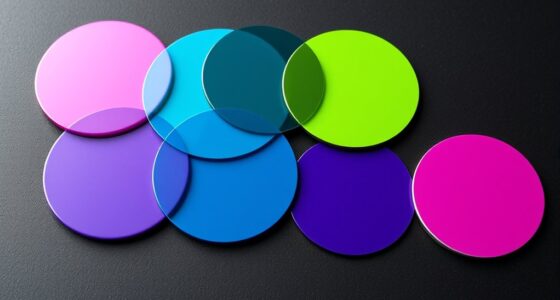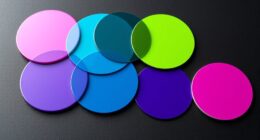Understanding warm versus cool lighting helps you create the right atmosphere. Warm light, with Kelvin ratings between 2700K-3000K, makes spaces cozy, relaxing, and flattering, perfect for living rooms and bedrooms. Cool light, above 5000K, offers bright, energizing illumination ideal for workspaces or retail areas. Choosing the right tone influences mood and functionality. If you want to learn how to balance these tones for your space, keep exploring the details below.
Key Takeaways
- Warm lighting (2700K–3000K) creates cozy, inviting atmospheres, ideal for relaxation and hospitality settings.
- Cool lighting (above 5000K) produces bright, bluish tones, suitable for tasks requiring high visibility and focus.
- Warm tones enhance skin appearance and promote comfort, while cool tones improve alertness and clarity.
- Warm lighting softens imperfections, making it ideal for living spaces; cool lighting emphasizes precision and cleanliness.
- The choice depends on the room’s purpose and desired mood, balancing ambiance with functional needs.
What Is Color Temperature and How Is It Measured?
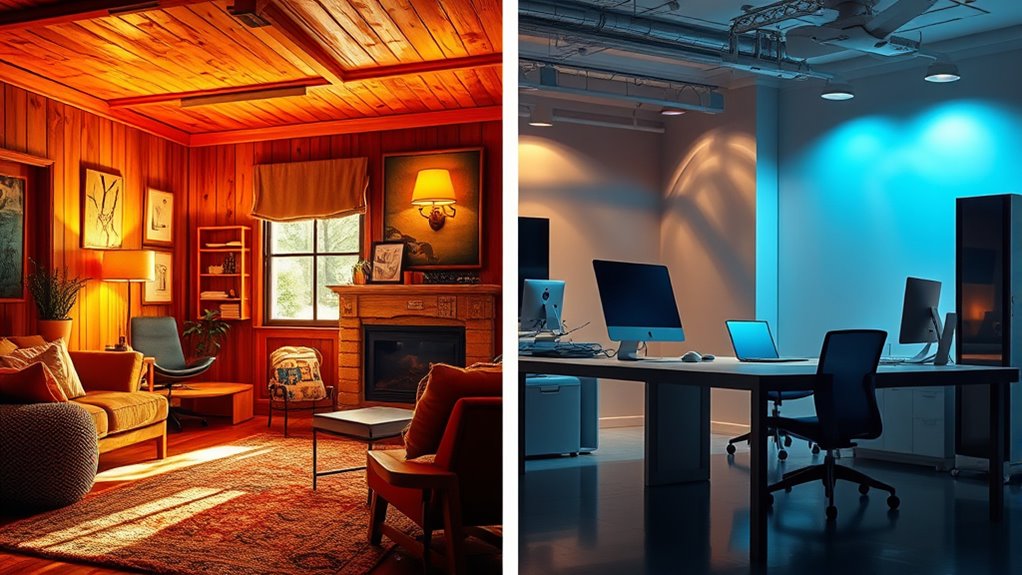
Color temperature describes the hue of light emitted by a source, and it’s measured in units called Kelvin (K). This measurement affects your color perception, influencing how objects appear under different lighting. For example, lower Kelvin values produce warmer, more yellow or orange light, while higher values create cooler, bluish tones. Understanding measurement units helps you compare lighting options accurately. When selecting lighting, knowing the color temperature allows you to choose the right ambiance or mood. It’s a straightforward way to gauge the warmth or coolness of a light source. By paying attention to these measurement units, you can better match lighting to your needs, whether for ambiance, task lighting, or aesthetic purposes.
Characteristics of Warm Lighting and Its Uses
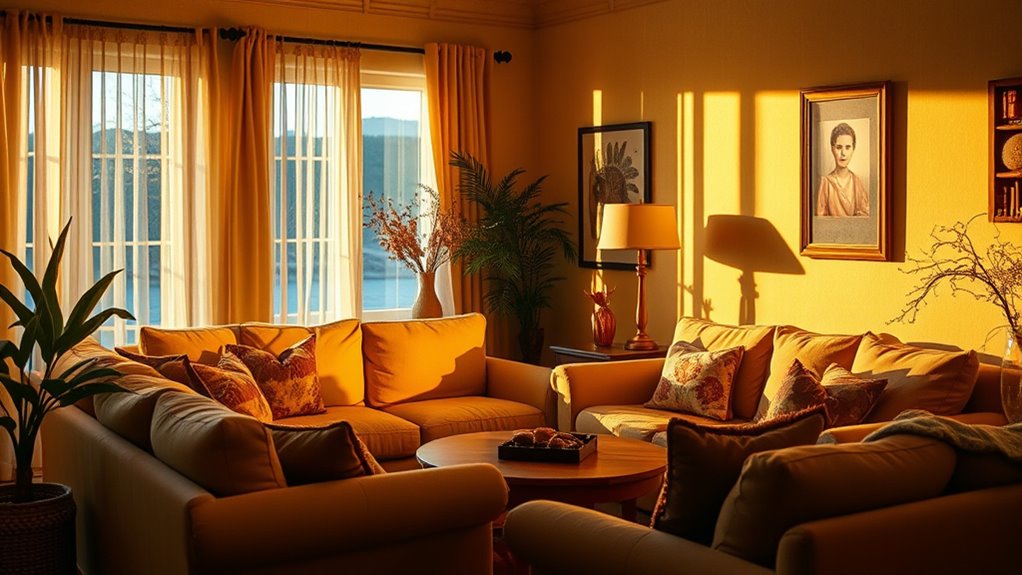
Warm lighting creates a cozy atmosphere that makes your space feel inviting and comfortable. It also enhances skin tones, helping you look your best in any setting. This type of lighting is perfect for living areas where you want to relax and unwind. Additionally, warm lighting can be used to create a welcoming environment in hospitality settings, emphasizing the importance of lighting characteristics in influencing mood. To maximize its benefits, understanding how color temperature affects perception can help in selecting the right lighting for different spaces. Incorporating lighting design principles ensures a harmonious and effective lighting setup. Using wall organization systems can also help optimize the ambiance by reducing clutter and creating a more cohesive aesthetic. Recognizing the impact of interior design basics can further enhance the overall mood and functionality of the space.
Cozy Atmosphere Creation
Creating a cozy atmosphere often involves lighting that feels inviting and relaxing. Warm lighting with its soft, amber glow helps set that mood, making your space feel comfortable and welcoming. Use ambient lighting to fill the room gently, avoiding harsh or direct illumination. Accent lighting can highlight specific areas or decor, adding depth and intimacy. To enhance the cozy vibe, pay attention to color matching—choose warm tones that complement your walls and furnishings. This harmony creates visual cohesion, further reinforcing the inviting environment. Incorporating textured fabrics can further enhance the warmth and comfort of your space. Additionally, selecting fixtures with warm color temperature can significantly contribute to a relaxed ambiance. When it comes to lighting options, choosing warm lighting fixtures like lamps or sconces with adjustable brightness can help tailor the atmosphere to your mood. Whether it’s a dimmed table lamp or soft wall sconces, warm lighting encourages relaxation and conversation. The use of smart lighting technology can also allow you to easily customize your lighting environment for different occasions. When you combine thoughtful ambient and accent lighting with matching colors, you craft a space that exudes warmth and comfort effortlessly.
Enhances Skin Tones
When you choose lighting that emphasizes warm tones, you’ll notice how it naturally enhances skin appearances, giving them a healthy, radiant glow. Warm lighting accentuates skin tone enhancement by softening imperfections and adding warmth that complements various complexions. This creates a flattering effect, making subjects look more vibrant and alive. In portrait photography, warm light helps highlight facial features and adds depth, resulting in images that feel inviting and genuine. It’s especially effective for capturing skin’s natural undertones, whether for professional headshots or casual portraits. By using warm lighting, you assure your subjects’ skin looks vibrant and appealing, drawing viewers into the photo and emphasizing their natural beauty effortlessly. Color temperature also plays a crucial role in setting the overall mood and tone of your images. Additionally, understanding the lighting technology behind different bulbs can help you select the most flattering options for your photography needs. Utilizing lighting quality considerations ensures the light distribution is smooth and flattering, further enhancing skin tones. Incorporating knowledge of hackathons can inspire innovative lighting techniques or creative projects that push your photographic boundaries. Moreover, selecting the right projector technology can significantly improve the visual presentation of your images and videos, making your work more impactful.
Ideal for Living Spaces
Because warm lighting adds a cozy and inviting atmosphere, it’s an excellent choice for living spaces. It creates a calming environment, perfect for relaxing or socializing. When planning your lighting installation, choose warm tones around 2700K to 3000K for a soft glow. This type of lighting enhances comfort and makes rooms feel more intimate. Additionally, warm lighting can improve energy efficiency, especially with LED options that consume less power. It’s versatile for various activities, from reading to unwinding. Keep these tips in mind:
- Use warm bulbs in ambient lighting fixtures
- Combine with dimmers for adjustable mood
- Opt for energy-efficient LEDs for longer lifespan
- Layer lighting with task and accent lights
- Maintain a balance to avoid overly yellow tones
- Consider lighting placement to maximize the cozy effect
- Be aware of potential pitfalls in adopting new payment technologies that could influence your choice of lighting options or energy management systems in smart homes
- Incorporating color temperature knowledge can help you select the most suitable lighting for your desired ambiance
- Incorporating natural materials like wood and linen can further enhance the warmth and rustic charm of your space.
Characteristics of Cool Lighting and Its Applications
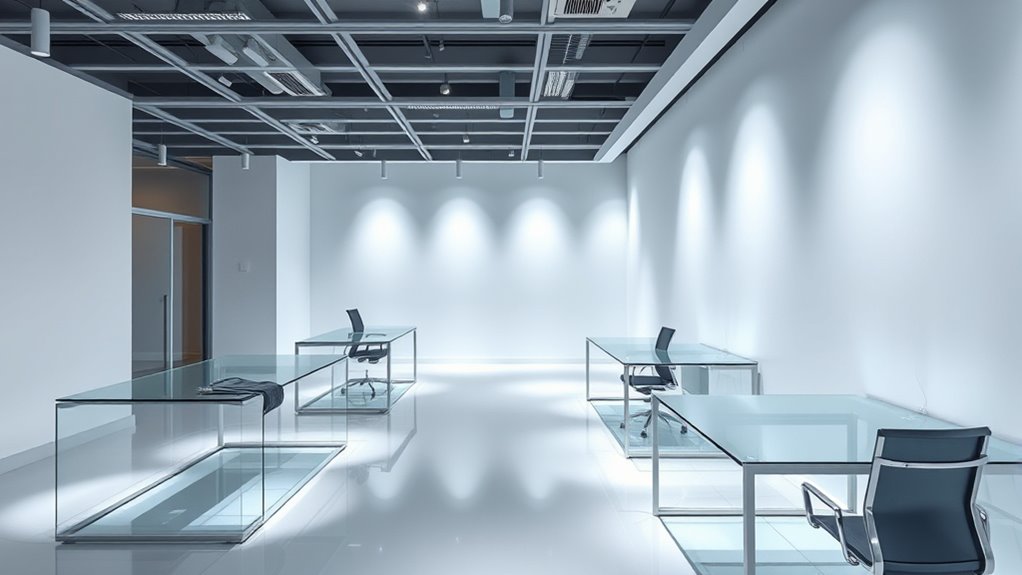
Cool lighting is characterized by its bluish-white hue, typically with color temperatures above 5000K. It offers high energy efficiency, making it ideal for environments that require bright, effective illumination without excessive power consumption. This type of lighting enhances clarity and focus, which is why it’s popular in workspaces, hospitals, and retail stores. Additionally, cool lighting generally provides good color rendering, helping to distinguish objects clearly and accurately. Its crisp appearance can boost alertness and productivity, especially in settings where precision matters. You’ll find cool lighting useful for tasks demanding high visibility and energy savings. However, it may create a sterile or unwelcoming atmosphere if overused in relaxed or personal spaces. Interestingly, in the context of affairs, public exposure on online platforms often reveals the stark contrast between discreet and overt behavior, similar to how lighting can dramatically affect perception. Overall, cool lighting’s characteristics make it suitable for functional, high-performance applications.
How to Choose the Right Color Temperature for Different Spaces
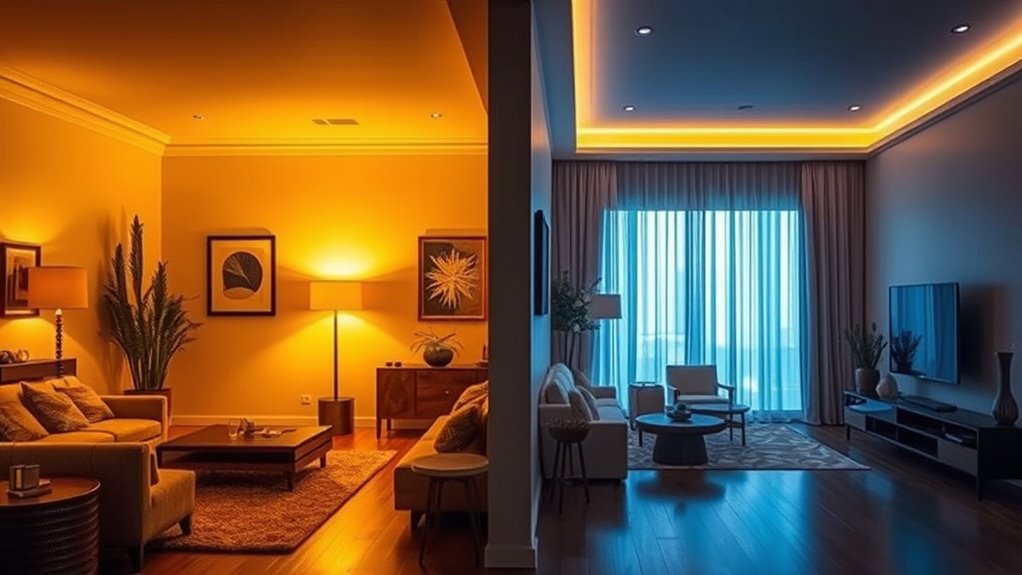
Choosing the right color temperature depends on the room’s purpose and the mood you want to create. For example, warmer tones work well in relaxing spaces, while cooler lights boost focus in work areas. Remember to take into account lighting placement to guarantee the color temperature enhances the space effectively. Incorporating attention in creative practice can also help you better assess how different lighting options influence the ambiance and functionality of your space. Being aware of color temperature effects can further optimize your lighting choices for specific needs and settings. Furthermore, understanding how narcissistic traits can influence perceptions of environment and control may inspire creative ways to incorporate lighting into fabric or decor projects. Additionally, exploring various textile line techniques may inspire creative ways to incorporate lighting into fabric or decor projects.
Room Function & Mood
The right color temperature can substantially influence the mood and functionality of a space. For relaxing areas like bedrooms, opt for warm, soft lighting to create a cozy atmosphere. In workspaces, cooler tones boost alertness and focus, ideal for productivity. Living rooms benefit from versatile lighting that balances warmth and coolness for comfort and socializing. When highlighting decorative accents, choose colors that enhance the ambiance without overpowering the decor. Additionally, selecting energy-efficient LED bulbs with adjustable color temperatures can save costs while allowing you to tailor the mood. Keep in mind that different room functions call for specific lighting to optimize both mood and practicality. Properly matching color temperature with room use enhances comfort, style, and energy efficiency.
Lighting Placement Tips
To effectively select the right color temperature for different spaces, you need to contemplate how lighting placement impacts both functionality and mood. Proper lighting placement ensures your chosen fixture positioning highlights the space’s purpose while enhancing its atmosphere. For task areas like kitchens or offices, position fixtures closer to work surfaces with cooler light to boost alertness. In living rooms or bedrooms, opt for warmer tones, placing fixtures where they create cozy, inviting corners. Consider ceiling-mounted lights or wall sconces to evenly distribute light, avoiding harsh shadows. Use adjustable fixtures or layered lighting to fine-tune the ambiance. Thoughtful lighting placement helps balance color temperature, ensuring each space feels comfortable, functional, and visually appealing.
The Impact of Warm and Cool Tones on Mood and Atmosphere
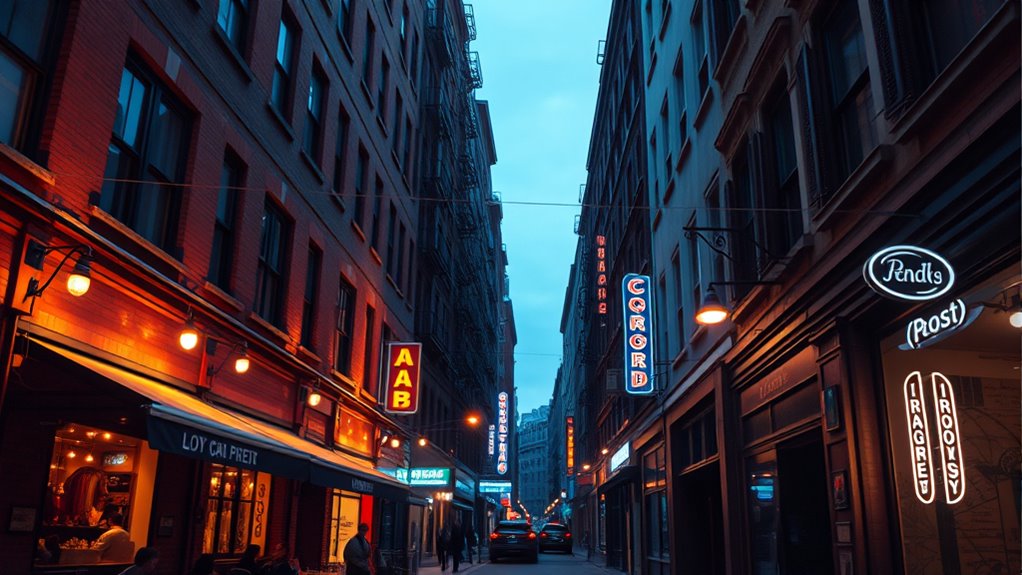
Warm and cool tones in a space can markedly influence your mood and the atmosphere you experience. Choosing the right tone creates an emotional impact that aligns with your intentions, whether calming or energizing. Warm tones evoke feelings of comfort, intimacy, and relaxation, making spaces feel inviting. Cool tones, on the other hand, promote calmness, focus, and freshness, enhancing productivity and clarity. These tones also contribute to design harmony, ensuring your environment feels cohesive and balanced. When selecting colors, consider how they’ll influence your emotional state and the overall vibe. Balancing warm and cool tones effectively can transform a space into a mood-enhancing environment tailored to your needs.
Balancing warm and cool tones creates a harmonious, mood-enhancing space tailored to your emotional needs.
- Enhance comfort and coziness
- Boost focus and clarity
- Create a sense of calm
- Foster energy and vibrancy
- Achieve visual balance and harmony
Technical Tips for Selecting Bulbs and Lighting Fixtures

Choosing the right bulbs and lighting fixtures begins with understanding the color temperature that best suits your space’s purpose. Pick warm tones for cozy areas or cool tones for task lighting. When selecting bulbs, consider their lifespan and energy efficiency to save costs long-term. LED bulbs are a popular choice because they last longer and consume less energy.
Here’s a quick guide:
| Purpose | Recommended Bulb Type | Color Temperature |
|---|---|---|
| Living Room, Bedroom | LED, Incandescent | Warm (2700K-3000K) |
| Kitchen, Office | LED, Fluorescent | Cool (3500K-5000K) |
| Accent Lighting | Dimmable LEDs | Adjustable |
Prioritize energy-efficient options for sustainability and longevity, ensuring your space stays well-lit and functional.
Creative Ways to Combine Warm and Cool Lighting for Visual Interest
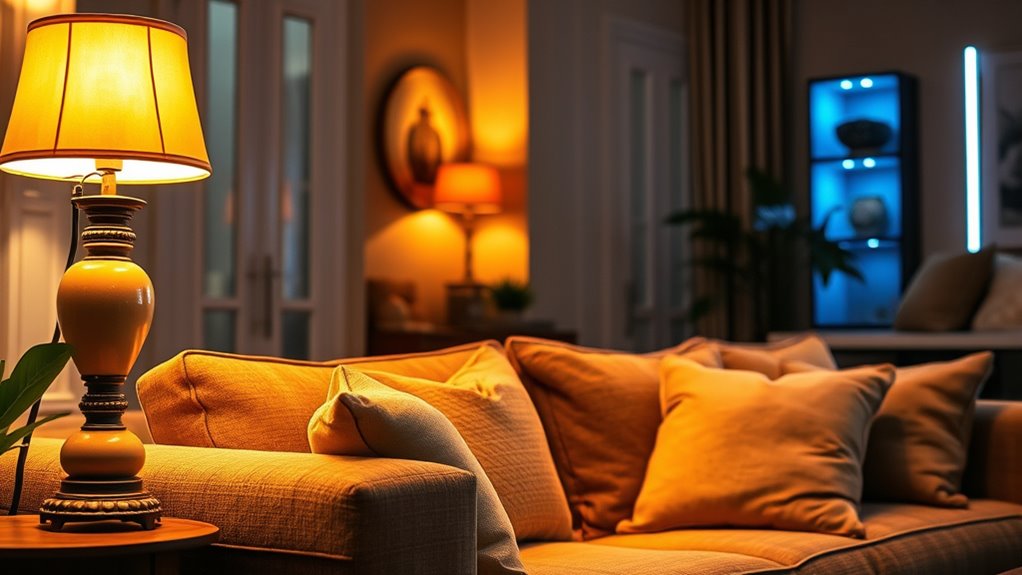
Blending warm and cool lighting can transform a space by adding depth and visual interest. To achieve this, consider using lighting layering to create dynamic environments. Play with color contrast by combining warm tones in seating areas with cool accents in artwork or architectural features. Incorporate different fixtures, like warm table lamps and cool overhead lights, to enhance mood and dimension. Use dimmers to adjust intensity and balance the color temperature throughout the space. Highlight focal points with cool lighting and fill background areas with warm tones for a cozy feel. Experiment with wall sconces, accent lights, or LED strips to create striking contrasts that draw the eye and add sophistication.
- Mix warm and cool bulbs in layered fixtures
- Use accent lighting to emphasize color contrast
- Incorporate dimming controls for versatility
- Highlight focal points with cooler tones
- Create zones with distinct color temperatures
Frequently Asked Questions
How Does Color Temperature Affect Energy Efficiency?
Color temperature impacts energy efficiency because it influences your lighting design choices. Cooler temperatures often require more LED efficiency to produce bright, crisp light, which can consume more energy. Warm tones tend to be more energy-efficient for creating cozy atmospheres. By selecting the right color temperature, you can optimize your LED efficiency, reducing energy use while achieving your desired ambiance. Your lighting design directly affects how effectively you use energy.
Can Color Temperature Influence Sleep Patterns?
You might notice that the color temperature of your lights influences your sleep cycle because cooler lights can suppress melatonin production, making it harder to fall asleep. Conversely, warmer lights promote melatonin release, helping you relax and prepare for rest. By choosing warm lighting in the evening, you support healthier sleep patterns, while cool lighting during the day keeps you alert. Adjusting your lighting based on your sleep cycle can improve overall rest quality.
Are There Health Risks Associated With Certain Lighting Temperatures?
Ever wonder if your lighting could harm you? Certain lighting temperatures can disrupt your circadian rhythms, making it harder to sleep and affecting your health. Cool, blue-toned light increases eye strain and alerts your brain, potentially leading to fatigue. Warm lighting is gentler, supporting natural rhythms, but prolonged exposure to harsh or overly cool lights might pose risks. Stay mindful of your lighting choices to protect your well-being.
How Does Outdoor Lighting Vary With Temperature?
Outdoor lighting varies with temperature, influencing both color rendering and mood setting. Cooler temperatures produce bluish light that enhances visibility and creates a crisp, energetic atmosphere, ideal for security. Warmer temperatures emit yellowish light, offering a cozy, inviting feel perfect for relaxing evenings. You notice these differences in streetlights, porch lamps, and landscape lighting, where choosing the right color temperature helps set the desired ambiance and guarantees proper color rendering for outdoor activities.
What Are the Latest Technological Advancements in Adjustable Lighting?
Imagine your lighting as a chameleon. With the latest advancements, you can control it effortlessly. Smart bulbs now use cutting-edge LED technology, allowing you to adjust brightness, color, and temperature via apps or voice commands. These innovations symbolize freedom and customization, transforming your space to match your mood or activity. Embrace this smart technology to create personalized atmospheres, making your environment more dynamic and responsive than ever before.
Conclusion
Choosing between warm and cool lighting is like painting with different moods—each stroke shaping the atmosphere you desire. By understanding their unique qualities and how they influence your space, you become the artist of your environment. Whether you want a cozy glow or a crisp, invigorating brightness, the right color temperature transforms your room into a canvas of emotion. Embrace the power of light, and let it tell your story with every luminous brushstroke.


